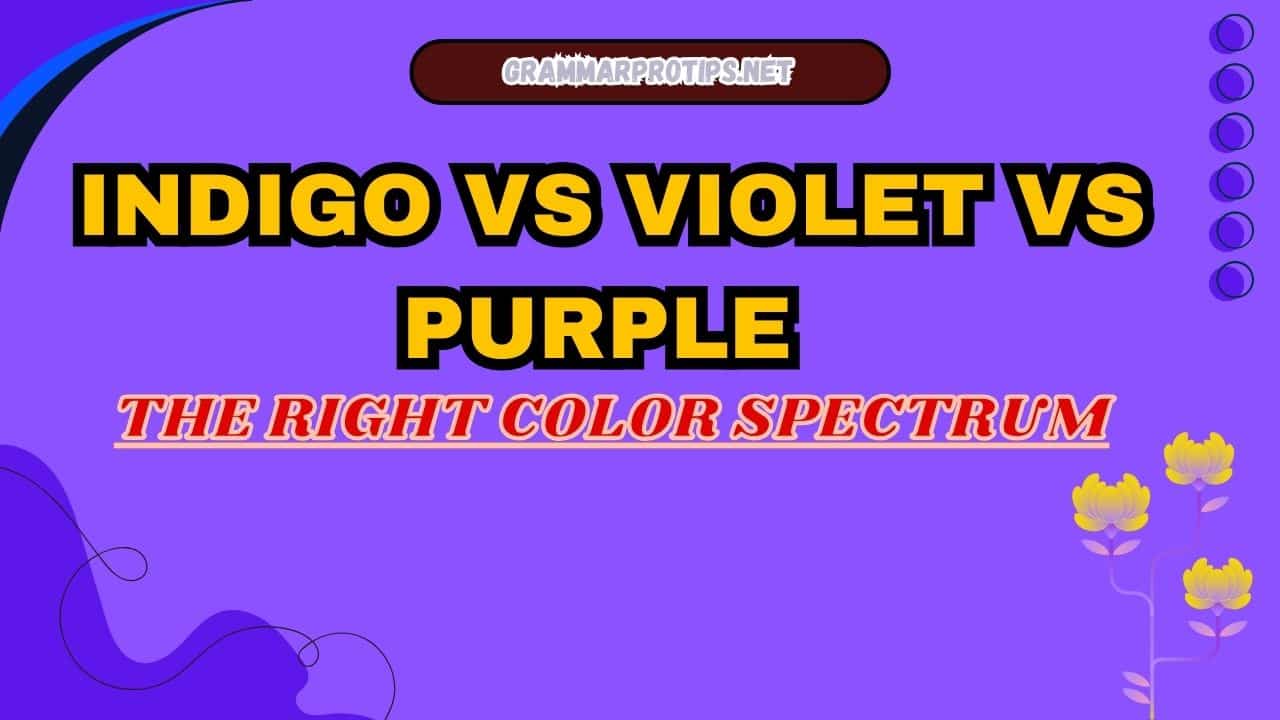Indigo vs Violet vs Purple: Color is one of the most powerful tools in design, fashion, art, and even communication. It has the ability to evoke emotions, influence decisions, and change perceptions.
However, when it comes to colors like indigo, violet, and purple, many people tend to use these terms interchangeably, even though they each represent distinct hues.
To help you navigate the nuances of these colors, this article will explore the indigo color, violet, and purple, breaking down their meanings, use cases, and differences.
Additionally, we’ll dive into some real-world scenarios to show you how these colors come to life in everyday applications, such as email communications, paint choices, and hair color trends.
By the end of this article, you’ll have a clear understanding of these shades, and you’ll be able to confidently choose the right color for your next project.
The Color Spectrum: Where Indigo, Violet, and Purple Fall
Before diving deep into the differences, it’s important to understand where each of these colors fits on the visible light spectrum.
The color spectrum is a range of colors produced by the dispersion of light, and indigo, violet, and purple each occupy distinct positions:
- Indigo: A rich, dark shade that sits between blue and violet. It often appears more blue than purple, creating a deeper, more mysterious tone.
- Violet: Lighter and brighter than indigo, violet has a strong blue presence but a bit more red compared to indigo. It’s associated with creativity and spiritual energy.
- Purple: A mixture of blue and red, purple can be cooler or warmer depending on the ratio of the colors. It’s a versatile color often associated with royalty, luxury, and imagination.
Let’s break down the key differences in the following table for quick comparison:
| Color | Position on the Spectrum | Key Characteristics | Common Associations |
|---|---|---|---|
| Indigo | Between blue and violet | Darker, cooler, deep blue-purple hue | Mystery, depth, calmness |
| Violet | Closer to blue, but with more red | Brighter and lighter than indigo | Creativity, spirituality, elegance |
| Purple | Mix of blue and red | Balanced, versatile hue, can lean warm or cool | Luxury, royalty, imagination |
Violet vs Purple vs Indigo: What’s the Difference?
The difference between indigo and blue and the distinctions between violet vs purple are often confusing. Here’s a deeper look at these differences:
- Indigo: A deep, dark color that leans more toward blue than purple, indigo has a rich, almost midnight feel to it. It’s often described as the color between blue and violet in the color spectrum.
- Violet: This color is closer to blue but contains enough red to give it a slight purple tint. Unlike indigo, which is darker, violet is brighter and more vibrant.
- Purple: Purple is the blend of blue and red, creating a color that is more balanced than either violet or indigo. Depending on the balance, purple can lean either toward blue (cool) or red (warm), but it always offers a rich, regal feel.
To better visualize this, let’s look at how these colors compare in different scenarios.
Scenario 1: Email Communication – Choosing the Right Color for Branding
Let’s say you’re designing a branding strategy for a new company. The colors you choose will help communicate the company’s values and personality.
Here’s how indigo, violet, and purple could impact your design:
Email Example:
Subject: Color Palette Ideas for Our Brand
Hi Sarah,
I’ve been thinking about the color scheme for our website and branding. For the main call-to-action buttons, I think indigo would be great it’s deep and trustworthy. Violet would work for our logo to make it stand out and feel creative. We could use purple for headers to create a balanced look that feels premium.
Let me know what you think!
Best,
John
In this example, indigo conveys trustworthiness, violet adds energy, and purple balances the design with a sense of luxury.
Scenario 2: Choosing Paint for Your Home – Which Color Should You Pick?
Now, let’s say you’re redecorating your living room, and you want to choose between indigo, violet, and purple paint colors. Here’s what you should consider:
- Indigo Paint: This color is darker and cooler, perfect for creating a cozy and sophisticated atmosphere. If you want your living room to feel calming and intimate, indigo would be a great choice.
- Violet Paint: Bright and lively, violet is perfect for adding vibrancy to the room. It’s ideal if you want a more creative and energizing space.
- Purple Paint: A rich purple hue can create a sense of luxury and elegance. It’s versatile, so it can be used in a variety of settings from cozy and warm to vibrant and bold.
Paint Example:
Subject: Which Paint Color Should We Choose?
Hi Laura,
I’m torn between indigo vs violet vs purple for the living room. Indigo seems like it would bring a lot of depth and calmness, but I’m worried it might make the room feel too dark. On the other hand, violet might make the space feel brighter and more energizing. Purple would give it a more luxurious vibe. What are your thoughts on these options?
Cheers,
Mark
Here, you’re weighing the impact of different colors based on the mood you want to set for the room.
Scenario 3: Hair Color – Bold Choices with Indigo, Violet, or Purple Hair
When it comes to hair color, the choices between indigo vs violet vs purple are becoming increasingly popular. These bold hues allow for self-expression and creativity. Here’s a breakdown of each color:
- Indigo Hair: Dark and bold, indigo creates a cool, mysterious vibe. It’s a great choice for those who want to stand out while maintaining an element of sophistication.
- Violet Hair: Violet hair is lively and bright, ideal for someone looking to make a statement. It adds a pop of color that’s playful and fun, yet still artistic.
- Purple Hair: Purple hair can vary in shade, but it’s always eye-catching. Whether you choose a pastel lavender or a deep royal purple, this color offers versatility and elegance.
Hair Color Example:
Subject: Thoughts on Hair Color
Hey Jess,
I’m considering changing my hair color and can’t decide between indigo vs violet vs purple. I’m leaning towards violet since it’s a little brighter and more fun. But indigo could look really striking if I want something darker. Do you think purple would be too much?
Let me know what you think!
Best,
Emma
In this case, you’re choosing a color that reflects your personal style and the mood you want to create.
The Role of Indigo, Violet, and Purple in Color Schemes
When creating a color scheme whether for a website, a painting, or a wardrobe—you’ll want to take into account how indigo, violet, and purple work together. These colors can be used harmoniously, or they can create contrast depending on the effect you’re trying to achieve.
- Indigo vs Violet vs Purple Color Scheme: A balanced scheme might involve indigo as the background color, violet for highlights, and purple for accents. This combination offers both contrast and harmony, making the design visually appealing.
- Indigo vs Violet vs Purple Paint: Pairing indigo walls with violet accessories and purple accents could create a stunning, layered effect that feels both dynamic and inviting.
- Indigo vs Violet vs Purple Hair: If you’re feeling adventurous, try mixing violet and indigo together in a hair color gradient or ombré style. Add some purple highlights to complete the look.
Final Thoughts: Choosing Between Indigo, Violet, and Purple
In conclusion, understanding the subtle differences between violet, purple, and indigo can be a game-changer in many areas of life, from designing your space to choosing your next hair color. Each of these colors carries a unique meaning and emotional impact:
- Indigo is calming, sophisticated, and introspective.
- Violet is energetic, creative, and spiritual.
- Purple is luxurious, versatile, and regal.
By knowing these distinctions, you’ll be able to make informed decisions, whether you’re selecting a violet color for your brand, deciding which is brighter indigo or violet for your design, or picking out the perfect color for your next art project.
Ultimately, each of these colors holds its own place in the spectrum, offering a range of possibilities based on your mood, setting, or aesthetic preferences.
So the next time you find yourself choosing between violet vs purple vs indigo, you’ll know exactly how to make the right choice.
Read more knowledgeable blogs on Grammar Pro Tips

Sienna Mauldon is a passionate writer and grammar expert. On her blog, she shares easy-to-follow guides to help readers master grammar rules and improve their writing. With a love for language and teaching, Sienna makes grammar simple and fun for everyone, from beginners to experienced writers.








